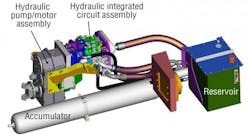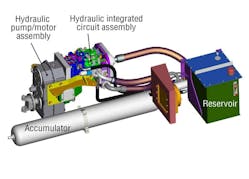One of the best ways for the refuse collection industry to achieve its “green” goals is to improve the efficiency of its existing fleet of trucks. Every gallon of fuel saved will have an immediate impact on both greenhouse gas generation and oil consumption.
It is a difficult challenge, because refuse trucks have an extremely difficult duty cycle that includes both inherently inefficient short-distance stop-and-go movement, and the periodic need for brief bursts of energy to compact and dump loads. They typically use a lot of fuel, up to 8000 gal each at an average of 32 gal a day for 250 days per year. They also require costly and intensive drivetrain, braking system, and compaction system component maintenance.
A significant portion of the world’s refuse collection fleet was designed and put into service when fuel was relatively inexpensive by today’s standards. That means that to be maximally effective, any efficiency improvements must be able to be retrofitted to many, or all, of the existing vehicles and designs in service.
Because these vehicles are trucks of one kind or another, the industry’s initial response to the need for improved efficiency naturally focused on the transportation aspect of the duty cycle — a system that harvests the kinetic energy of the moving truck that is normally dissipated as braking heat and recycles it into motion as the truck accelerates.
Capturing energy increases efficiency
This is most easily accomplished with a hydraulic system that uses a pump to capture the kinetic energy while the vehicle decelerates and stores it as pressurized fluid in an accumulator. That pressurized fluid is then used to power a hydraulic motor connected to the vehicle’s drivetrain when the vehicle accelerates.
Eaton has been a pioneer in Hydraulic Launch Assist technology systems for use in refuse trucks. Eaton’s Spencer, Iowa plant is the world’s largest producer of commercial parallel HLA systems for both OEM and retrofit applications on refuse trucks, shuttle busses, service trucks, and other vehicles with similar duty cycles. Refuse trucks equipped with Spencer-produced HLA systems have been driven more than 250,000 miles in daily operation, saving millions of gallons of diesel fuel.
Rising fuel costs create new needs
Moving is only one of the functions performed by a refuse truck, however. Nearly all refuse trucks also have onboard systems to compact the waste they collect, and many also have systems to lift and dump the waste containers. These systems are hydraulically powered in virtually all cases.
Traditionally these onboard systems have been powered with fixed displacement gear or vane pumps driven directly off the front of the engine crankshaft. This arrangement was the most cost-effective way to use the available technology when the systems were designed.
Remember, however, that this was during the era of inexpensive diesel fuel. So manufacturers focused on low cost components that met the basic functional needs of the loading and compaction systems. Designing for efficiency was not considered, resulting in systems that drew unneeded engine power even when not being used for the compaction cycle.
Things, of course, have changed. With the HLA system addressing the transport efficiency issue, onboard compaction/handling hydraulics has become the next focus for systemic improvement. The issue here is not capturing and recycling energy but rather generating and delivering it only when needed with minimal losses while idling.
The solution is to replace the fixed displacement gear and vane pumps with a variable displacement piston-type pump operating through load-sensing valves and manifolds. Such a system consumes almost no power while idle (when the pump is moving essentially no fluid), yet it can quickly ramp up its output to match a load applied to the system.
By supplying power only when it is actually needed, a system like Eaton’s Power-On-Demand can dramatically reduce the amount of diesel fuel used by a refuse truck. When paired with an HLA system the fuel savings can reach 25 to 40% compared to traditionally-equipped trucks based on actual field experience.
Eaton’s prototype POD systems have demonstrated annual fuel savings of $4000 to $6000 per truck based on daily fuel savings of 4 to 7 gal per truck and $3 per gallon diesel fuel.
Another advantage to using variable displacement piston pumps is the ability to vary the displacement with increased engine speed. This eliminates the need for added over-speed control valves typically used with gear and vane pump systems. These valves bypass part of the flow back to the pump inlet above a certain engine speed. Besides improving the efficiency of the circuit, productivity is improved because the packer mechanism can work at all engine speeds.
Yet another advantage of a variable displacement pump is the ability to match engine power by utilizing constant torque controls, either electronic or built into the pump. By using constant torque controls, pack at idle is easily attained, which also reduces noise and further improves system efficiency.
A simplified design
Finally, in addition to fuel savings and increased productivity, POD systems may be simpler than the traditional hydraulic systems they replace. They can have fewer connections, longer lasting components, and offer increasingly sophisticated opportunities for integration through electronic sensors and controls. In addition to complete systems designed with the box OEMs, Eaton has developed a retrofit program that accommodates an estimate 80% of the existing front load and rear load units in service, and offers some of same fuel and emissions savings outlined above. But, whether new or retrofitted, tomorrow’s fleet of refuse trucks will be smarter, more efficient, and more productive. The fuel they don’t burn and the greenhouse gasses they don’t emit will let us all breathe a little easier.
Corey Moore is Market Segment Director – Commercial, Government and Military Transportation at Eaton corp., Eden Prairie, Minn. Contact him at [email protected] or visit www.eaton.com for more details.


